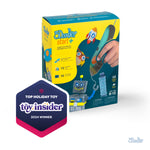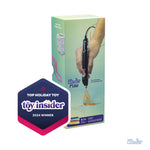Developing a Character
In this lesson, students will work in small groups to craft a story character through a process of answering interview questions, identifying related characteristics, designing a character emoji with a 3Doodler and writing a short POV narrative based on inferences.

KnowledgeStudents havediscussed character perspective
discussed character traits
written short narratives
had practice using 3Doodler
discussed character perspective
discussed character traits
written short narratives
had practice using 3Doodler
ObjectivesStudents willrecognize that "knowing" your character will improve a story.
understand that answers to interview questions should not be random.
a character's character traits and history will determine his or her decisions and behavior.
create 5 stencils for 3Doodler emoji brows, eyes and mouth.
design 3Doodler stamps for playdough emoji brows, eyes and mouth.
recognize that "knowing" your character will improve a story.
understand that answers to interview questions should not be random.
a character's character traits and history will determine his or her decisions and behavior.
create 5 stencils for 3Doodler emoji brows, eyes and mouth.
design 3Doodler stamps for playdough emoji brows, eyes and mouth.
MaterialsStudents will need3Doodler (1 per group)
pencils (2-3 per group group)
scrap paper (1-2 per group)
foam board (precut a set of 5 - 2" x 2" blocks per group)
playdough (1 - 7 ounce canister per group)
glue sticks (1 per group)
scissors (1 per group)
See Resources: Character Interview (1 per group)
See Resources: Character Traits (*for teacher reference)
See Resources: Character Trait List (1 per group)
See Resources: Face Stencils Template (1 per group)
3Doodler (1 per group)
pencils (2-3 per group group)
scrap paper (1-2 per group)
foam board (precut a set of 5 - 2" x 2" blocks per group)
playdough (1 - 7 ounce canister per group)
glue sticks (1 per group)
scissors (1 per group)
See Resources: Character Interview (1 per group)
See Resources: Character Traits (*for teacher reference)
See Resources: Character Trait List (1 per group)
See Resources: Face Stencils Template (1 per group)
Lesson PlanInstructions
Step 1State the goal: Using a 3Doodler and writing a brief narrative from a character's perspective.
Step 2Note that knowing someone well enables us to make inferences about his or her behavior.
Step 3Brainstorm and record character traits. *Character Trait List for teacher reference.
Step 4Model answering Interview Questions from an imaginary story character's perspective.
Based on responses, make inferences about this character's personality.
Step 5List 8-10 character traits on Character Trait Template.
On the board, sketch various brows, eyes and mouths that reflect different character traits, e.g, eager, timid, evil, happy.
Step 6Using a pencil, fill in the Face Stencil Template with selected brows, eyes and a mouth that reflect your character's traits.
Step 7Cut and glue 1 facial feature onto each of the 5 foam blocks.
Step 8Use a 3Doodler to trace over stencil lines 3-4 times to create sufficient height from the stencil block base. This will be your stamp.
Step 9Create an emoji-character with play dough: Roll and flatten. Press down on play dough with each emoji stamp, eyes, brows, and mouth. Name your emoji character.

![]()
![]() Step 10
Step 10Collaborate on a POV narrative in a given scenario. Example: What would your character do if he or she found a wallet on a deserted street? Make inferences based on what they know about the character. While writing:
Review appropriate pronouns for first person narrative: "I, me, myself, mine, etc."
Note there may be more than one possible response, and group members will need to compromise.
Step 11Remind students how narrative events must follow a logical sequence.
Step 12Divide students into groups and hand out Interview Worksheets, Face Stencil Templates and pencils.
Assign tasks to group members: recorder, artist, modeler or have students share roles.
Step 13Prompt students to complete interview questions, list 8-10 related character traits, sketch various possible stencils, 3Doodle as stamps and stamp in play dough.
Step 14Culminate project with POV narrative.
State the goal: Using a 3Doodler and writing a brief narrative from a character's perspective.
Note that knowing someone well enables us to make inferences about his or her behavior.
Brainstorm and record character traits. *Character Trait List for teacher reference.
Model answering Interview Questions from an imaginary story character's perspective.
Based on responses, make inferences about this character's personality.
List 8-10 character traits on Character Trait Template.
On the board, sketch various brows, eyes and mouths that reflect different character traits, e.g, eager, timid, evil, happy.
Using a pencil, fill in the Face Stencil Template with selected brows, eyes and a mouth that reflect your character's traits.
Cut and glue 1 facial feature onto each of the 5 foam blocks.
Use a 3Doodler to trace over stencil lines 3-4 times to create sufficient height from the stencil block base. This will be your stamp.
Create an emoji-character with play dough: Roll and flatten. Press down on play dough with each emoji stamp, eyes, brows, and mouth. Name your emoji character.

Collaborate on a POV narrative in a given scenario. Example: What would your character do if he or she found a wallet on a deserted street? Make inferences based on what they know about the character. While writing:
Review appropriate pronouns for first person narrative: "I, me, myself, mine, etc."
Note there may be more than one possible response, and group members will need to compromise.
Remind students how narrative events must follow a logical sequence.
Divide students into groups and hand out Interview Worksheets, Face Stencil Templates and pencils.
Assign tasks to group members: recorder, artist, modeler or have students share roles.
Prompt students to complete interview questions, list 8-10 related character traits, sketch various possible stencils, 3Doodle as stamps and stamp in play dough.
Culminate project with POV narrative.
Wrap Up
Assessment
Possible Extensions
Resources
Vocabulary
perspective - the relation of two figures in the same plane.
Educational Standards
Orient the reader by establishing a situation and introducing a narrator and/or characters; organize an event sequence that unfolds naturally.
Students will write a POV narrative in first person from their emoji-character's perspective. The story must follow a logical sequence of events.
Produce clear and coherent writing in which the development and organization are appropriate to task, purpose, and audience.
Student's POV narrative will demonstrate an understanding of the task, purpose and audience, i.e., their peers.
Describe in depth a character, setting, or event in a story or drama, drawing on specific details in the text (e.g., a character's thoughts, words, or actions).
Students will describe an event drawing on specific details, e.g. character's thoughts, words and actions based on their character's interview and related character traits.
Define a simple design problem that can be solved through the development of an object, tool, process, or system and includes several criteria for success and constraints on materials, time, or cost.
Students will work in small groups to design a set of face of stamps for an emoji-character based on criteria set by teacher.
Generate and compare multiple possible solutions to a problem based on how well each is likely to meet the criteria and constraints of the problem.
Students will work in small groups to discuss various designs before settling on one for their emoji-character.
Plan and create a design document to illustrate thoughts, ideas, and stories in a sequential (step-by-step) manner (e.g., story map, storyboard, sequential graphic organizer).
Students will create stencils that reflect their thoughts and ideas about character traits.
Students will refer to their stencil designs and stamps to make inferences about their character's behaviors while writing their POV narratives.
Decompose (break down) a larger problem into smaller sub-problems with teacher guidance or independently.
The task of writing a POV narrative will be broken down into a series of simple tasks: answering questions, listing character traits, modeling an emoji.
Articulate and set personal learning goals, develop strategies leveraging technology to achieve them and reflect on the learning process itself to improve learning outcomes.
Students will use the 3Doodler to leverage personal learning goals, i.e., writing a POV narrative. Students will culminate project in a discussion to reflect on the process, its outcomes and how to improve on subsequent experiences.
Use technology to seek feedback that informs and improves their practice and to demonstrate their learning in a variety of ways.
Students will use the 3Doodler to visually demonstrate character traits associated with interview responses.
Exhibit a tolerance for ambiguity, perseverance and the capacity to work with open-ended problems.
Students will demonstrate willingness and competency within an open-ended task with more than one possible outcome.
Create original works or responsibly repurpose or remix digital resources into new creations.
Students will create original character-emojis using playdough and 3Doodler.
Use collaborative technologies to work with others, including peers, experts or community members, to examine issues and problems from multiple viewpoints.
Students will collaborate using the 3Doodler throughout this exercise with group members.
Students will listen, share ideas and compromise.
Contribute constructively to project teams, assuming various roles and responsibilities.
Students will share and support each other by taking on various roles, e.g., sketching, recording, modeling, stamping, writing.





